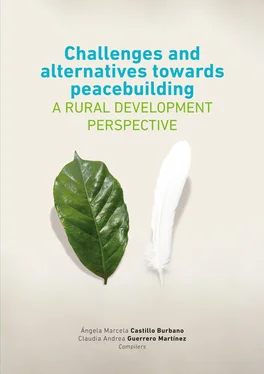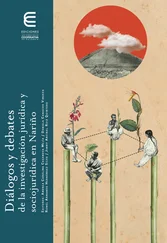Finally, in a transversal manner to all the problems addressed, we must mention the stagnation of the productive processes and rural development in the regions. Due to the dynamics of the conflict, many communities have had to continue their productive economy with illicit crops. When they have refused to obey the requirements of armed actors in this regard, they have been arbitrarily deprived of their territories. Institutional abandonment, coupled with the threat of illegal actors, has increased their situation of vulnerability and marginalization in the countryside.
It is necessary for the State to implement policies that allow for the recovery of fallow lands, the imposition of progressive tax burdens and the arrangement of land for its distribution among those with fewer resources within the rural population, for which the formalization of property rights, with mechanisms that prevent their appropriation illegally, is essential. Development must be planned in the territories, strategies built from the bottom up, campesinos must organize the settlements, which requires an institutional redesign that allows for the dream of a countryside at peace where social justice is fulfilled (PNUD, 2012).
Against this backdrop, we can identify some especially urgent challenges. First, it is necessary to implement a comprehensive rural reform that promotes the development of the regions, contributing to reducing inequality and poverty gaps. Second, an execution of measures aimed at the disarticulation of networks that promote illicit activities based on drug trafficking, as well as the structuring of a true and effective policy for the substitution of illicit crops, is urgently needed. Third, urgent attention should be given to the paramilitary phenomenon and to act against the increase in selective killings within the communities that occupy the post-conflict territories. And fourth, none of this can be truly robust without the prompt implementation and complete regulation of the JEP, whose main function will be to ensure the rights of the victims. In order to address these challenges, a real political commitment is needed, mainly aimed at recognizing the importance of these territories and their inhabitants, the need to make a greater investment in different spheres, such as education, health and employment, a drive to promote infrastructure, a greater institutional presence and rethinking the function of the land according to constitutional parameters.
Conclusions
In Colombia, especially in rural territories, conflicts associated with land use and tenure and the difficulties associated with decision-making have been catalyzing factors for the violence derived from the internal armed conflict. These have also contributed to widening the inequality and poverty gap. The department of Nariño has not been exempt from such consequences, since more than half of its population is located in rural areas.
With the signing of the “Final Agreement for the End of Conflict and the Construction of a Stable and Lasting Peace”, a transitional justice process has begun on which the post-conflict must be founded. After the disarmament and demobilization of the FARC, there are three great pillars for the construction of a stable and lasting peace. The first, the question of the Colombian countryside, which requires a comprehensive rural reform and a solution to the problems of illicit drugs. The second, the transformation of armed confrontation into political discussion, as well as the opening of democratic spaces. And, thirdly, the rights of the victims, which are structured around a system of judicial and extrajudicial mechanisms aimed at guaranteeing truth, reparation, justice and non-recurrence.
Progress in the implementation of the Agreement has been accompanied by great difficulties and setbacks. Although the victimizing events decreased significantly in much of the country, in some areas, the social dynamics derived from the conflict have experienced serious complications. This is the case of Nariño, where violence has escalated and the murder rate shows a worrying upward trend. The quantity of crops for illicit use has increased in the Nariñense fields, with the voluntary replacement programs not having flourished to the desired extent. It is important to rethink the strategies for this region and, among other measures, increase public investment, state presence, access to resources and productive projects, as well as promote accompaniment and technical advice. The construction of a stable and lasting territorial peace involves urgently and comprehensively addressing these challenges.
References
Acuerdo Final para la Terminación del Conflicto y la Construcción de una Paz Estable y Duradera. (2016). Suscrito por el Gobierno de la República de Colombia y las Fuerzas Armadas Revolucionarias de Colombia - Ejército del Pueblo (FARC-EP) el 24 de noviembre de 2016.
Bejarano, J. (1985). Campesinado, luchas agrarias e historia social en Colombia: notas para un balance historiográfico. En: P. González (coord..), Historia política de los campesinos latinoamericanos, (pp. 9-72). Ciudad de México: Siglo XXI.
Centro Nacional de Memoria Histórica. (2013). ¡Basta ya! Colombia: Memorias de guerra y dignidad. Bogotá: Imprenta Nacional.
Comisión Internacional de Verificación de Derechos Humanos en Colombia. (2018). Informe de seguimiento. Recuperado el 10 de julio de 2018 de https://www.colectivodeabogados.org/IMG/pdf/libro_jako11.pdf
Corte Constitucional. (2014). Sentencia C-180/14. [Magistrado ponente: Alberto Rojas Ríos].
Fundación Paz y Reconciliación. (2018a). Cómo va la Paz. Informe n. 4.
Fundación Paz y Reconciliación. (2018b). Cómo va la Paz. Pacífico. Informe de junio de 2018.
García-Durán, M. (2010). Colombia: conflicto armado, procesos de negociación y retos para la paz, en A. Vargas (ed.), Colombia: Escenarios Posibles de Guerra o Paz, (p. 265). Bogotá: Universidad Nacional de Colombia,
López, W. (1999). Las políticas de la paz y los procesos de negociación en Colombia. Breve Balance y perspectivas, Convergencia. Revista de Ciencias Sociales, 6(19), 245-274.
Molano, A. (2015). Fragmentos de la historia del conflicto armado (1920-2010). Bogotá: Universidad de Antioquia.
ONU. (2004). Informe del Secretario General “El Estado de derecho y la justicia de transición en las sociedades que sufren o han sufrido conflictos”, del 3 de agosto de 2004 (Doc. S/2004/616, 2004).
ONU. (2005). Principios y directrices básicos sobre el derecho de las víctimas de violaciones manifiestas de las normas internacionales de derechos humanos y de violaciones graves del derecho internacional humanitario a interponer recursos y obtener reparaciones, aprobados por resolución 60/147 de la Asamblea General de 16 de diciembre de 2005 (Doc. A/Res/60/147, 2005).
ONU. (2012). Informe del Relator Especial sobre la promoción de la verdad, la justicia, la reparación y las garantías de no repetición, de 9 de agosto de 2012 (Doc. A/HRC/21/46, 2012).
Pineda, F. (2016). La lucha por la tierra en Colombia: génesis de un conflicto que no acaba, Goliardos, Revista estudiantil de Investigaciones Históricas, (20), 10-21.
Registro Único de Víctimas (2017). Red Nacional de Información. Recuperado el 10 de julio de 2018 de http://rni.unidadvictimas.gov.co/RUV.
Uprimny, R. (2006). Introducción. En R. Uprimny, C. Botero Marino, E. Restrepo, Esteban y M. P. Saffon, Justicia transicional sin transición? Reflexiones sobre verdad, justicia y reparación en Colombia. Bogotá: Antropos.
Vacas, F. (2015). El Derecho Internacional ante el conflicto de Colombia. Valencia: Tirant lo Blanch.
Villamil, C. (2015). La reforma agraria del Frente Nacional. De la concentración parcelaria de Jamundí al Pacto del Chicoral. Bogotá: Universidad de Bogotá Jorge Tadeo Lozano.
Читать дальше












